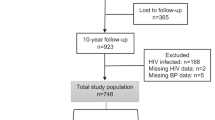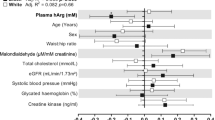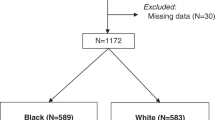Abstract
Lower nitric oxide (NO) bioavailabilty associates with hypertension in patients and elderly populations. With hypertension known to develop earlier in black populations, we compared both plasma and urinary NO-related markers and their associations with central systolic blood pressure (cSBP) and arterial stiffness in healthy young black and white adults. We included healthy black and white men and women (n = 1110; 20–30 years) and measured cSBP and pulse wave velocity (PWV), along with both plasma and urinary arginine, homoarginine, asymmetric dimethylarginine (ADMA), symmetric dimethylarginine (SDMA), as well as urinary ornithine/citrulline, nitrite and nitrate. In addition, the urinary nitrate-to-nitrite ratio (UNOxR) was calculated. The black men and women had higher cSBP and higher plasma arginine and ADMA, but lower urinary nitrate and UNOxR (all p ≤ 0.003) than their white counterparts. In single and forward stepwise multiple regression analyses, we found an inverse association of cSBP (adj. R2 = 0.124; β = –0.134; p = 0.006) and plasma homoarginine in black men. Central SBP associated inversely with UNOxR in black women only (adj. R2 = 0.171; β = –0.130; p = 0.029). In the white women, cSBP associated positively with urinary ADMA (adj. R2 = 0.372; β = 0.162; p = 0.015). PWV associated inversely with plasma ADMA (adj. R2 = 0.253; β = –0.163; p = 0.024) in the white women only. The lower NO synthesis and the higher cSBP in our black cohort support the notion of a potential increased risk for future large artery stiffness and hypertension development in later life.
This is a preview of subscription content, access via your institution
Access options
Subscribe to this journal
Receive 12 digital issues and online access to articles
$119.00 per year
only $9.92 per issue
Buy this article
- Purchase on Springer Link
- Instant access to full article PDF
Prices may be subject to local taxes which are calculated during checkout

Similar content being viewed by others
References
Opie LH. Heart disease in Africa. Lancet. 2006;368:449–50.
Zhou D, Xi B, Zhao M, Wang L, Veeranki SP. Uncontrolled hypertension increases risk of all-cause and cardiovascular disease mortality in US adults: the NHANES III Linked Mortality Study. Sci Rep. 2018;8:9418.
Li Q, Yon JY, Cai H. Mechanisms and Consequences of eNOS Dysfunction in Hypertension. J Hypertension. 2016;33:1128–36.
Moncada S, Palmer RM, Higgs EA. Nitric oxide: physiology, pathophysiology, and pharmacology. Pharm Rev. 1991;43:109–42.
Lundberg JO, Weitzberg E, Gladwin MT. The nitrate-nitrite-nitric oxide pathway in physiology and therapeutics. Nat Rev Drug Discov. 2008;7:156–67.
Naseem KM. The role of nitric oxide in cardiovascular diseases. Mol Asp Med. 2005;26:33–65.
Reckelhoff JF, Kellum JA, Blanchard EJ, Bacon EE, Wesley AJ, Kruckeberg WC. Changes in nitric oxide precursor, L-arginine, and metabolites, nitrate and nitrite, with aging. Life Sci. 1994;55:1895–902.
Takase H, Sugiyama M, Nakazawa A, Sato K, Ueda R, Dohi Y. Long-term effect of antihypertensive therapy with calcium antagonist or angiotensin converting enzyme inhibitor on serum nitrite/nitrate levels in human essential hypertension. Arzneimittelforschung. 2000;50:530–4.
Wang H, Liu J. Plasma asymmetric dimethylarginine and L-arginine levels in Chinese patients with essential hypertension without coronary artery disease. J Cardiovasc Dis Res. 2011;2:177–80.
Glyn MC, Anderssohn M, Lüneberg N, Van Rooyen JM, Schutte R, Huisman HW, et al. Ethnic-specific differences in L-arginine status in South African men. J Hum Hypertens. 2012;26:737–43.
Mels CM, Huisman HW, Smith W, Schutte R, Schwedhelm E, Atzler D, et al. The relationship of nitric oxide synthesis capacity, oxidative stress, and albumin-to-creatinine ratio in black and white men: the SABPA study. Age. 2016;38:9.
Schutte AE, Schutte R, Huisman HW, Van Rooyen JM, Fourie CM, Malan L, et al. Dimethylarginines: their vascular and metabolic roles in African and Caucasians. Eur J Endocrinol. 2010;162:525–33.
Schutte AE, Gona PN, Delles C, Uys AS, Burger A, Mels CMC, et al. The African Prospective study on the early detection and identification of cardiovascular disease and hypertension (African-PREDICT): design, recruitment and initial examination. Eur. J Prev Cardiol. 2019;26:458–70.
Carlson RV, Boyd KM, Webb DJ. The revision of the Declaration of Helsinki: past, present and future. Br J Clin Pharm. 2004;57:659–713.
Kiers HD, Hofstra JM, Wetzels JFM. Oscillometric blood pressure measurements: differences between measured and calculated mean arterial pressure. J Med. 2008;66:474–9.
Van Bortel LM, Laurent S, Boutouyrie P, Chowienczyk P, Cruickshank JK, De Backer T, et al. Expert consensus document on the measurement of aortic stiffness in daily practice using carotid-femoral pulse wave velocity. J Hypertens. 2012;30:445–8.
Inker LA, Schmid CH, Tighiouart H, Eckfeldt JH, Feldman HI, Greene T, et al. Estimating glomerular filtration rate from serum creatinine and cystatin C. N Eng J Med. 2012;367:20–29.
Schwedhelm E, Tan-Andresen J, Maas R, Riederer U, Schulze F, Böger RH. Liquid chromatography-tandem mass spectrometry method for the analysis of asymmetric dimethylarginine in human plasma. Clin Chem. 2005;51:1268–71.
Atzler D, Mieth M, Maas R, Böger RH, Schwedhelm E. Stable isotope dilution assay for liquid chromatography-tandem mass spectrometric determination of L-homoarginine in human plasma. J Chromatogr B Anal Technnol Biomed Life Sci. 2011;879:2294–8.
Hanff E, Lützow M, Kayacelebi AA, Finkel A, Maassen M, Yanchev GR, et al. Simultaneous GC-ECNICI-MS measurement of nitrite, nitrate and creatinine in human urine and plasma in clinical settings. J Chromatogr B Anal Technol Biomed Life Sci. 2017a;2017:207–14.
Tsikas D, Hanff E, Bollenbach A, Kruger R, Pham VV, Chobanyan-Jürgens K, et al. Results, meta-analysis and a first evaluation of UNOxR, the urinary nitrate-to-nitrite molar ratio, as a measure of nitrite reabsorption in experimental and clinical settings. Amino Acids. 2018;50:799–821.
Melikian N, Wheatcroft SB, Ogah OS, Murphy C, Chowienczyk PJ, Wierzbicki AS, et al. Asymmetric dimethylarginine and reduced nitric oxide bioavailability in young Black African men. Hypertension. 2007;49:873–7.
Moss MB, Brunini TM, Soares De Moura R, Novaes Malagris LE, Roberts NB, Ellory JC, et al. Diminished L-arginine bioavailability in hypertension. Clin Sci. 2004;107:391–7.
Perticone F, Sciacqua A, Maio R, Perticone M, Maas R, Böger RH, et al. Asymmetric dimethylarginine, L-arginine and endothelial dysfunction in essential hypertension. J Am Coll Cardiol. 2005;46:518–23.
Van der Zwan LP, Davids M, Scheffer PG, Dekker JM, Stehouwer CD. Teerlink T. L-Homoarginine and L-arginine are antagonistically related to blood pressure in elderly population: the Hoorn Study. J Hypertens. 2013;31:1114–23.
Litwin M, Obrycki L, Niemirska A, Sarnecki J, Kulaga Z. Central systolic blood pressure and central pulse pressure predict left ventricular hypertrophy in hypertensive children. Pediatr Nephrol. 2019;34:703–12.
Schneider JY, Rothmann S, Schröder F, Langen J, Lücke T, Mariotti F, et al. Effects of chronic oral L-arginine administration on the L-arginine/NO pathway in patients with peripheral arterial occlusive disease or coronary artery disease: L-Arginine prevents renal loss of nitrite, the major NO reservoir. Amino Acids. 2005;47:1961–74.
Said MY, Bollenbach A, Minović I, Van Londen M, Frenay AR, de Borst MH, et al. Plasma ADMA, Urinary ADMA excretion, and late mortality in renal transplant recipients. Amino Acids. 2019;51:913–27.
Bode-Böger SM, Scalera F, Kielstein JT, Martens-Lobenhoffer J, Breithardt G, Fobker M, et al. Symmetrical dimethylarginine: a new combined parameter for renal function and extent of coronary artery disease. J Am Soc Nephrol. 2006;17:1128–34.
Matsuoka H, Itoh S, Kimoto M, Kohno K, Tamai O, Wada Y, et al. Asymmetric dimethylarginine, an endogenous nitric oxide synthase inhibitor, in experimental. Hypertension Hypertension. 1997;29:242–7.
Wolf C, Lorenzen JM, Stein S, Tsikas D, Störk S, Weidemann F, et al. Urinary asymmetric dimethylarginine (ADMA) is a predictor of mortality risk in patients with coronary artery disease. Int J Cardiol. 2012;156:289–94.
Gkaliagkousi E, Gavriilaki E, Triantafyllou A, Nikolaidou B, Anyfanti P, Koletsos N, et al. Asymmetric dimethylarginine levels associated with augmentation index across naïve untreated patients with different hypertension phenotypes. J Clin Hypertens. 2018;20:680–5.
Serg M, Kampus P, Kals J, Zagura M, Muda P, Tuomainen TP, et al. Association between asymmetric dimethylarginine and indices of vascular function in patients with essential hypertension. Blood Press. 2011;20:111–6.
Päivä H, Kähönen M, Lehtimäki T, Raitakari OT, Jula A, Viikari J, et al. Asymmetric Dimethylarginine (ADMA) has a role in regulating systemic vascular tone in young healthy subjects: the cardiovascular risk in Young Finn Study. Am J Hypertens. 2008;21:873–8.
Kielstein JT, Impraim B, Simmel S, Bode-Böger SM, Tsikas D, Frölich JC, et al. Cardiovascular effects of systemic nitric oxide synthase inhibition with asymmetric dimethylarginine in humans. Circulation. 2004;109:172–7.
Acknowledgements
The authors are grateful towards all individuals participating voluntarily in the African-PREDICT study. The dedication of the support and research staff as well as students at the Hypertension Research and Training Clinic at the North-West University (Potchefstroom campus) are also duly acknowledged.
Funding
Funding The African-PREDICT study: The research funded in this manuscript is part of an ongoing research project financially supported by the South African Medical Research Council (SAMRC) with funds from National Treasury under its Economic Competitiveness and Support Package; the South African Research Chairs Initiative (SARChI) of the Department of Science and Technology and National Research Foundation (NRF) of South Africa (GUN 86895); SAMRC with funds received from the South African National Department of Health, GlaxoSmithKline R&D (Africa Non-Communicable Disease Open Lab grant), the UK Medical Research Council and with funds from the UK Government’s Newton Fund; as well as corporate social investment grants from Pfizer (South Africa), Boehringer-Ingelheim (South Africa), Novartis (South Africa), the Medi Clinic Hospital Group (South Africa) and in kind contributions of Roche Diagnostics (South Africa). Any opinion, findings, and conclusions or recommendations expressed in this material are those of the authors, and therefore, the NRF does not accept any liability in this regard.
Author information
Authors and Affiliations
Corresponding author
Ethics declarations
Conflict of interest
The authors declare that they have no conflict of interest.
Additional information
Publisher’s note Springer Nature remains neutral with regard to jurisdictional claims in published maps and institutional affiliations.
Supplementary information
Rights and permissions
About this article
Cite this article
Craig, A., M. C. Mels, C., Tsikas, D. et al. Central systolic blood pressure relates inversely to nitric oxide synthesis in young black adults: the African-PREDICT study. J Hum Hypertens 35, 985–993 (2021). https://doi.org/10.1038/s41371-020-00453-9
Received:
Revised:
Accepted:
Published:
Issue Date:
DOI: https://doi.org/10.1038/s41371-020-00453-9



